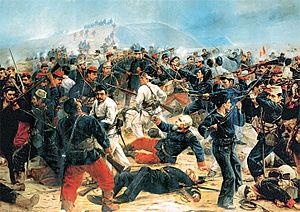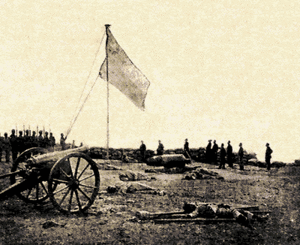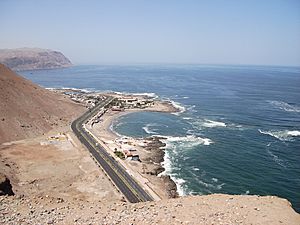Battle of Arica facts for kids
Quick facts for kids Battle of Arica |
|||||||
|---|---|---|---|---|---|---|---|
| Part of the War of the Pacific | |||||||
 The Battle of Arica by Juan Lepiani shows Bolognesi's final moments. |
|||||||
|
|||||||
| Belligerents | |||||||
| Commanders and leaders | |||||||
| Strength | |||||||
| 5,479 | 1,628 | ||||||
| Casualties and losses | |||||||
| 474 killed or wounded | 1,000 killed or wounded 1 monitor lost |
||||||
The Battle of Arica was an important fight during the War of the Pacific. It happened on June 7, 1880, between the armies of Chile and Peru. This battle is also known as the Assault and Capture of Cape Arica.
After the Battle of Tacna, Bolivia left the war. This meant Peru had to fight alone. Chile needed a port close to its army to get supplies, send more soldiers, and help the wounded. So, the Chilean leaders decided to attack Arica, which was Peru's last strong point in the Tacna area.
The Chilean army, led by Colonel Pedro Lagos, launched a huge attack on Arica. About 1,600 Peruvian defenders faced more than 8,000 Chilean soldiers. The Chileans attacked from both the sea and the land. They captured the Morro de Arica (Cape Arica) in just 55 minutes. The Peruvian troops, led by Colonel Francisco Bolognesi, fought bravely. Colonel Bolognesi, many officers, and over 1,000 men died defending the city.
Chile's victory ended the part of the war called the Campaign of Tacna and Arica. This meant Chile now controlled the Tarapacá and Tacna regions. After this, a new stage began, called the Lima Campaign. This campaign ended seven months later when Chile captured Peru's capital city.
Arica never returned to Peru. It was given to Chile temporarily after the Treaty of Ancon in 1884. Chilean forces occupied the city until the Treaty of Lima was signed in 1929. Then, Arica officially became part of Chile forever.
Contents
What led to the Battle of Arica?
Since the war began in 1879, the fighting at sea ended when Chile captured the Peruvian warship Huáscar on October 8, 1879. After this, the Chilean Army landed at Pisagua on November 2 and pushed the Peruvian and Bolivian forces inland. Chile won battles at Germania and San Francisco. However, Peru won a battle at Tarapacá on November 27. Even with this win, Peru lost the Tarapacá area. Because people were unhappy, both the President of Peru, Prado, and the President of Bolivia, Hilarión Daza, were replaced.
On February 27, the Chilean Navy started to bombard Arica's defenses from the sea. These defenses could shoot up to 3.5 kilometers. They protected Peru's last ironclad ship, the Manco Cápac. The Huáscar, now a Chilean warship, was repaired and given new, powerful guns. It arrived in Arica on February 25 to help block the port. Another Chilean ship, the "Magallanes," joined it later.
The Chilean ships and the Peruvian "Manco Cápac" had many fights that didn't end clearly. Even though the Peruvian monitor ship was older, it was protected by land defenses. It managed to keep the Chilean ships away for four months. During this time, the Chilean captain Thomson died and was replaced by Carlos Condell. On April 9, the Peruvian port of Callao was also blocked by Chilean ships.
Land movements before the main battle
On March 8, a Chilean force went to Mollendo to cut off communication between that port and Arequipa, where 4,000 Peruvian soldiers were. On March 22, the Chileans won the Battle of Los Ángeles Hill. After this, the Chilean forces marched towards Tacna. This was a very difficult march. During this time, the Chilean Minister Rafael Sotomayor died and was replaced by Jose Francisco Vergara.
On May 26, the Chilean army completely defeated a combined Peruvian and Bolivian army of 10,000 soldiers near Tacna. This battle was very important because Bolivia left the war and never fought again. From then on, Peru had to fight alone.
After getting their troops ready again, the Chilean leaders decided to capture the port of Arica. Since the entire Peruvian and Bolivian army in Tacna was defeated, Arica was an easier target for the large Chilean army. Since February, the Peruvian soldiers in Arica had been cut off from supplies because of the naval blockade. On June 1, Chilean troops captured Engineer Teodoro Elmore. From him, they learned where the landmines around the city were hidden. About 7,500 Chilean soldiers were sent from Tacna to Arica by train in early June.
Chile asks Peru to surrender
Early on June 5, a Chilean officer named José de la Cruz Salvo went to the Peruvian lines with a white flag. He wanted to talk to the commander of Arica. Salvo was taken to Colonel Bolognesi's headquarters. Here's what they said:
- Salvo: Sir, the Chilean General wants to avoid more bloodshed. After beating the Allied Army at Tacna, he sent me to ask you to surrender with all your men, food, and ammunition.
- Bolognesi: I have important duties to do, and I will do them until the last bullet is fired.
- Salvo: Then, my job here is done.
After talking with his officers, Bolognesi told Salvo: "Tell your general that I am proud of my officers. I am determined to fight until the last bullet to defend Arica, because it must not fall into your hands!" The phrase "until the last cartridge has been fired" (hasta quemar el último cartucho) is now a famous saying and the official motto of the Peruvian Army.
The armies involved
Peru's situation and forces
After losing the battle in Tacna, the Peruvian soldiers in Arica lost contact with their main army. Only five survivors from Tacna reached Arica with news. Colonel Bolognesi still hoped that part of the Allied army would come to help him. However, the Peruvian leaders had decided to leave Arica because they knew it would be lost. A messenger was sent to tell Bolognesi to abandon the city, but he never arrived.
When Chilean forces started to gather around Arica, Bolognesi's troops were completely alone. The capture of Engineer Teodoro Elmore was a big blow. He was supposed to blow up railroads the Chileans had taken. With his capture, the Chilean army learned where the minefields were. This made their ground attack easier.
The Peruvian army in Arica had 1,628 men. They had cannons in three main groups: East, North, and South. The northern group had cannons like the Santa Rosa and San José. The east group had seven cannons, protected by a sand trench. The southern group had eight cannons. In total, they had nineteen cannons.
The Peruvian foot soldiers were from the 7th and 8th divisions. They mostly had Chassepot rifles, which were not as powerful as the Chilean weapons.
Chile's situation and forces
After the Battle of Tacna, the Chilean army had suffered many losses. They realized they needed a port in the area to get supplies and help the wounded. So, 4,500 men were sent to Arica. Another 13,000 soldiers stayed near Tacna. This made it impossible for the smaller Peruvian army to reinforce Arica.
The Chilean army stayed near Tacna for a few days after their victory. This stopped the Peruvians from sending help to Arica or telling them to leave the port. General Baquedano decided to send part of the army, led by Colonel Pedro Lagos, to Arica. This force included several regiments like the "Buin" 1st Line Regiment and the 4th Line Regiment. They also had cavalry and artillery. The Chilean foot soldiers had modern Comblain and Gras rifles. With the arrival of the Lautaro Battalion, the Chileans had about 8,000 soldiers.
The battle begins
Chile's battle plans
After the Battle of Tacna, Colonel Pedro Lagos was ordered to take Arica no matter what. He could decide how to do it. Lagos chose a direct attack with 4,000 foot soldiers, divided into three groups. He wanted a fast attack to surprise the enemy before the powerful mines at the Cape could explode.
The main targets were the three main defenses of the city: the East Fort, the Ciudadela (Citadel) Fort, and finally the Cape Fort. The 3rd Line Regiment would take the Ciudadela Fort, with the "Buin" 1st Line Regiment ready to help. The 4th Line Regiment would attack the East Fort. Colonel Lagos didn't want too much bloodshed, so he asked Colonel Bolognesi to surrender. But Bolognesi refused, saying he would fight until his last bullet. So, both sides got ready for battle.
Peru's battle plans
The Peruvian forces had little choice but to wait for the attack. They knew they would likely lose, but they wanted to make it as hard as possible for the Chileans.
The whole city was mined to cause as many casualties as possible when the Chilean army passed through. Engineer Elmore had studied the ground to place many landmines. He placed five groups of mines on the right side, seven on the left, and four in the center. Each group had ten charges, and each charge had ten kilograms of dynamite. There were also many mines in the city itself. Under the park, where the Chilean Bulnes Battalion stood for a long time, there was a huge mine with 30 quintals of dynamite. This was meant to blow up the entire city.
The assault
Under the cover of night, the 3rd Line and 4th Line regiments marched towards the Azapa Valley and their targets. Peruvian guards at the Ciudadela Fort saw the Chilean soldiers and started firing. The 3rd Line Regiment quickly ran to the fort and captured it in hand-to-hand combat. The defenders were defeated very fast. The Chileans were furious about the landmines and took almost no prisoners. Only the Chilean officers stopped a complete massacre of the Peruvian troops.
The same thing happened at the East Fort. The 4th Line Regiment captured this fort, also outnumbering and destroying the defenders with a direct charge. The remaining Peruvian defenders then went back to their main defense on the Cape, fighting and trying to get their lines back in order. At this point, Colonel Lagos wanted to wait for more soldiers from the "Buin" 1st Line Regiment before attacking the Cape Fort. At the same time, the Peruvian monitor Manco Cápac, which was defending the Cape from the sea, was attacked by four Chilean warships, including the Huáscar. Both armies exchanged artillery fire.
However, an unknown soldier suddenly shouted, "¡Al morro muchachos!" ("To the Cape, boys!"). This caused a huge, unplanned charge. The Chilean officers had no choice but to follow their soldiers in a wild race for the top. The foot soldiers had to run up the hill, facing the Peruvian men led by Colonel Bolognesi. The Chilean attack quickly became a confusing mess, with mines exploding everywhere. The defenders were overwhelmed and wiped out. Colonel Bolognesi had planned to blow up his gunpowder when the Chileans reached the fort to cause massive casualties. However, he couldn't do it and died in the fight along with most of his men.
The final attack was led by Major Juan José San Martín (who died in battle) and Sergeant Major Felipe Solo de Zaldívar. Sergeant Major Zaldívar was the first to reach the top of the Cape. After just 55 minutes, Chilean troops had captured the Cape.
What happened after the battle?
The Chileans won the battle, and Colonel Bolognesi was killed. Other high-ranking Peruvian officers who died included Colonel Alfonso Ugarte. He famously rode his horse off a cliff into the Pacific Ocean to stop the Chilean forces from capturing the Peruvian flag. Colonel Mariano Bustamante, Bolognesi's Chief of Detail, also died. These three Peruvian officers were part of the group that refused to surrender to the Chilean army. They were the ones who supported Colonel Bolognesi's promise to fight until the last bullet.
One high-ranking officer who survived the battle was Lieutenant Colonel Roque Sáenz Peña. He was a volunteer officer in the Peruvian Army and later became the President of Argentina.
Since the Morro de Arica was the last strong defense for the Peruvian troops in the city, Arica was quickly captured. The Chilean soldiers who attacked the city killed many surviving and surrendering Peruvian soldiers and citizens. The city was then looted.
With the city captured, the Peruvian ironclad Manco Cápac had very few supplies. The nearest friendly port was Callao, four days away. Since it was impossible to reach Callao, the ship was sunk by its crew to prevent the Chilean military from capturing it. The torpedo boat Alianza tried to escape Arica and reach Mollendo. But it was chased by the Chilean ironclad Cochrane and the armed transport Loa. The Loa continued the chase alone. At Punta Picata, Tacna, the boat got stuck because its engines overheated. Its crew then blew it up with a torpedo to stop the enemy from capturing it.
Arica is still part of Chile today. It is a constant reminder of past tensions with Peru and Bolivia. For Peru, June 7 is celebrated as Flag Day, honoring the brave actions of Bolognesi, Ugarte, and the rest of the soldiers. The Chilean Army celebrates the anniversary as Infantry Day each year, remembering the courage of the thousands of Chilean foot soldiers who fought and won the battle.
Images for kids
-
The Battle of Arica by Juan Lepiani depicts Bolognesi's final moments. Oil on canvas, Lima, Peru.
See also
 In Spanish: Batalla de Arica para niños
In Spanish: Batalla de Arica para niños






